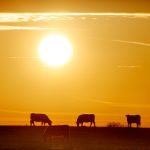Long-time readers of this newspaper, particularly those in the cattle business, know Barbara Duckworth’s name. As the Western Producer’s primary livestock reporter, her byline appeared thousands of times in these pages over a 32-year career that ended with her retirement in 2020. Barbara Duckworth Thompson died Oct. 7, from cancer, at the age of 70. […] Read more
Opinion

Trade renegotiation only benefits U.S.
There is a ticking time bomb at the heart of the North American economy. Canadian businesses and analysts have been pressuring the federal government to better prepare for the mandated renegotiation of the United States-Mexico-Canada Agreement that regulates trade and economic activity among the three countries. Article 34.7 of the pact commits them to review […] Read more

American agricultural exports continue their downward slide
When you set a record ag trade deficit for the third consecutive year, the decline isn’t an aberration or a coincidence. It is, in fact, growing proof that a key element of your national ag policy is headed in the wrong direction. And, according to an Outlook for U.S. Agricultural Trade report released by the […] Read more

Navigating the info storm requires source query
Some months ago, during a personal conversation with a farmer, he held up his smartphone in exasperation, saying, “how do you know what to believe?” The flippant answer would have been to tell him to download our AGCanada app to access the Western Producer and our sister publications. But “trust us” is a pretty inadequate […] Read more

Gov’t program requires application, financial reporting
The Sustainable Canadian Agricultural Partnership (SCAP) is a key pillar in fostering Canada’s ongoing modernization, development and prosperity. This partnership represents a substantial investment of $3.5 billion over a five-year period (2023-28) by all levels of government. The aim is to bolster innovation, competitiveness and flexibility within the agricultural food and product sector. This project […] Read more

Ranching has vital role in Prairie conservation
Born and raised in Calgary, we took many family camping trips into the Prairies. I was always awed by the massive expanses of grasslands, the endless blue skies and the diversity of birds, mammals and insects we would see. I remember having to clean our windshield at every stop along the way because the dead […] Read more

Should sustainability approach be carrot or stick?
An extra requirement is coming for the AgriInvest program for 2025. Producers with allowable net sales of $1 million or more per year will require an environmental assessment to receive the matching government contribution. The change in AgriInvest came out of the federal/provincial/territorial agriculture ministers meeting more than two years ago. Little has been heard […] Read more

Cow cuddling the latest in animal therapy
There’s something about animals that many humans find therapeutic. Well, maybe not a grizzly bear charging out of the tree line, but lots of other animals. Many people find animals so calming that they have been incorporated into formal therapy programs. Dog therapy is probably one of the most well-known, whether it be formalized therapy […] Read more

Innovation adoption lags in farming
Every innovative product of technology that is commercialized eventually reaches what is known as “full adoption.” This is the point at which the peak percentage of society has adopted an innovation. Some innovations reach the point of full adoption more rapidly than others or have higher full adoption rates. The adoption rate of seatbelts in […] Read more

Massive Nebraska feedlot ‘just the opposite of what we need’
Like farmers and ranchers, veterinarians love to pour concrete. Many build customized facilities dedicated to their animal health mission: examination rooms, operating theaters, cattle chutes, holding pens and loading docks. Three Canada-based vets, however, are pouring enough concrete in far southwestern Nebraska to cover what they say will be a square mile — 640 acres […] Read more




